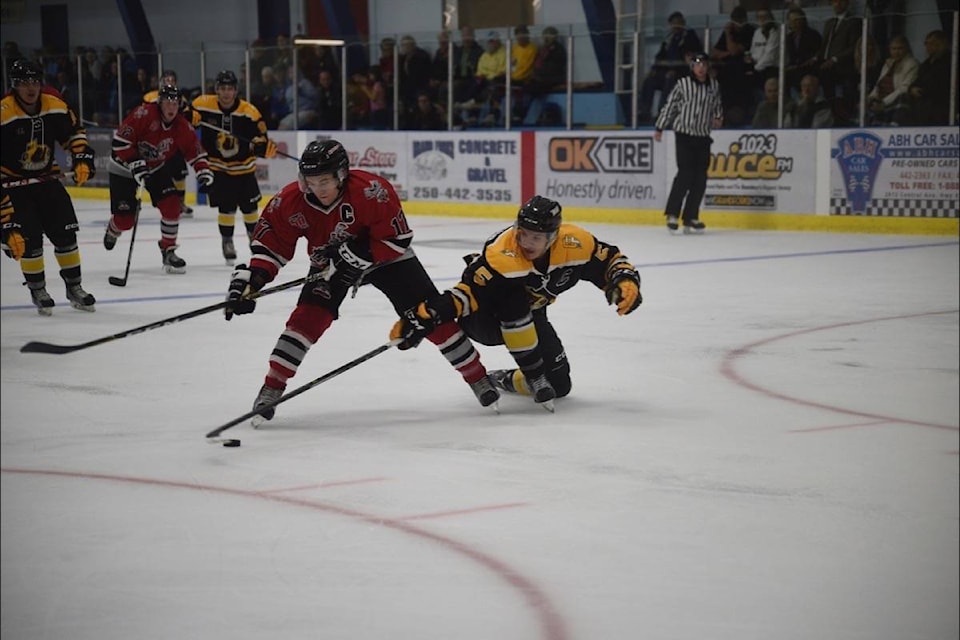New BC Hockey regulations requiring all Junior B teams to wear full-face masks aim to make the game safer for players, but Grand Forks Border Bruins’ head coach and general manager Emery Olauson isn’t so sure that will be the case.
BC Hockey announced last week that full face protection will be mandatory at the Junior B level, beginning next season. The change will affect 42 teams, including all those in the local Kootenay International Junior Hockey League (KIJHL). BC Hockey’s Junior Committee, Chief Executive Officer Barry Petrachenko said it is responding to the pace of the game.
“Our game is faster than it has ever been, and as a result we face increased challenges and responsibilities relative to safety,” said Petrachenko in a release. “We are confident that through this initiative facial and dental injuries will be greatly reduced.”
However, Bruins’ coach Emery Olauson doubts the change will be a good one.
“My opinion, and my opinion only but that I think is shared with lots of hockey people, is the more protection you surround players with, the faster the game gets and the more unsafe it is,” he said.
“My feeling is with full face protection you are going to see higher speed collisions, more stick work, and more head-first collisions,” Olauson said. “Probably limiting teeth [injuries], [but] we will probably be looking at more concussions and more ‘lack of respect’ injuries.
Olauson also said players aren’t a fan of the change – taking off the full-face protection (sometimes known as a “cage”) and donning a half-shield is seen as a rite of passage once players graduate from minor hockey.
He also questions the “pace of the game” rationale provided by BC Hockey.
“Are they saying that Junior B is faster than Junior A or the WHL, because they have not imposed this rule on those leagues,” he added.
BC Hockey, an arm of Hockey Canada, governs teams from the pre-minor level (ages 5 and 6) to midget (17 and younger) and junior (played by ages 16-20). Junior hockey is split into three divisions: Major Junior, Junior A and Junior B. Major junior is the most advanced level of play.
Insurance for Junior B teams is through BC Hockey, which handles claims when players are injured. The Bruins have a longstanding relationship with BC Hockey, Olauson said, and players file a claim with BC Hockey in the event of a dental injury, such as lost teeth or other dental injuries.
The Bruins see a few facial injuries (including lost teeth and stitches) every year, and Olauson does concede that there will likely be fewer dental claims with the new protection rule. However, Olauson said he feels there will be more, not fewer, injuries overall.
“I don’t doubt is the thought that this will limit facial injuries, I just don’t agree it will. We will loose fewer teeth, but I think cuts will be there, concussions and stick injuries will go up,” Olauson said.
Olauson said he also wasn’t pleased that the teams were not consulted individually – however, KIJHL president Bill Ohlhausen says the mandate has been in the works for months, and he fully supports it.
“It’s something that has been developing over the last couple years, and it’s going to cut down on the insurance costs, it’ll cut down on all the facial injuries, and that’s the biggest thing,” Ohlhausen told Black Press last week.
“The insurance part of it is really quite expensive,” said Ohlhausen. “We carry an extra insurance policy that is quite a bit of money for each of the teams.”
Olauson said the KIJHL Board of Governors meeting is set to be held in January, and he anticipates the subject will come up at that meeting, specifically as to why the Junior B leagues were chosen for face protection.
“No matter what the outcome of the decision, whether leagues fight back, I think quality of entertainment will just get better,” Olauson said. “I would urge fans not to think this is any less of junior hockey, it will be fast, fun hockey to take in, the players will just be wearing facial protection.”
Between 2010 and 2015, there were 370 dental injuries among visor-wearing players and only eight occurred among fully-masked players. Dental injuries among visor players accrued a cost of $287,775, versus the $7,548 among full face players in the league.
With the new full face protection requirement, the league expects to see a 71 per cent reduction in major medical and dental costs under the Hockey Canada Insurance Program.
-With reporting contributed by Jim Bailey, Trail Times
